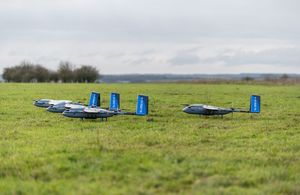UK and US research labs conduct back-to-back AI demonstrations
Dstl and the US Air Force Research Laboratory carried out the first deployment of their jointly developed artificial intelligence toolbox in 2 military exercises.

UK suppliers Blue Bear, Fraser Nash Consulting, IQHQ and Rowden Technologies provided the swarm and payload technology that underpinned the experiments
The state-of-the-art toolbox will allow the warfighter to rapidly select the best AI tools, from across the coalition, for their specific mission needs.
The goal of both exercises was to address the challenge of how to make AI agile, adaptable, trustworthy and accessible to the warfighter under different US and UK military use cases. Critically, this also included a process to ensure that the AI being developed and delivered is robust for the mission and that any limitations of the AI are understood by the user, key steps in developing user trust in the technology.
In November 2022, a team of 30 AI and autonomy experts from the UK and US deployed as a joint AI Taskforce to the Project Convergence 22 (PC22) experiment held at the US National Training Centre at Fort Irwin. Just 4 weeks later, a subset of the Taskforce reconvened at the British Army’s Salisbury Plain Training Area in Wiltshire England taking lessons learned from PC22 and rapidly applying AI into a new operational environment as part of the Dstl HYDRA project’s Integrated Concept Evaluation (ICE).
The focus of the joint AI Taskforce for PC22 was to deploy, for the first time, the jointly developed UK-US AI Toolbox. The toolbox draws together data collected from UK-US uncrewed ground vehicles (UGVs) and uncrewed aerial vehicles (UAVs), data labelling, rapid AI training and retraining on deployed tactical high performance computers (HPCs) to deliver mission-specific AI.
The team has worked to make the AI understandable to the user, developing model cards to provide clear descriptions of the strengths and weakness of the AI algorithms being delivered by the toolbox so that users can select the algorithms they need for their mission and understand the risks of employing it outside of its planned use case to meet a mission outcome.
UK AI Toolbox lead Todd Robinson said:
The whole team across both nations came together to deliver this landmark trial for the collaboration.
By deploying our AI Taskforce to PC22, we learned what this technology would mean to the warfighter and identified further challenges which require research and development to enhance a future operational capability.
It is important we deploy AI into trials more regularly to drive the maturation and operationalisation of AI.
US AI Toolbox lead Dr. Lee Seversky said:
It is becoming more and more critical to be able to adapt AI to meet changing mission requirements, operating environments, and accelerated decision timelines in-mission, all while ensuring it is trusted and understandable to the military users.
The joint AI Toolbox, with its ability to adapt and deliver AI for different joint military missions is critical. AI flexibility and speed is key to moving us towards this goal.
The second deployment of the AI Toolbox was on UK platforms as part of the Dstl HYDRA project’s Integrated Concept Evaluation (ICE) trials on Salisbury Plain.
ICE4 demonstrated that UK-US developed algorithms from the AI Toolbox could be deployed onto a swarm of UK UAVs and retrained by the joint AI Taskforce at the ground station and the model updated in flight, a first for the UK. This demonstrated how the AI toolbox can adapt to new data sources, platforms, and operating locations to provide rapid updates to the AI deployed onto Autonomous Systems.
HYDRA Project Technical Authority Dr Chris Jones said:
ICE4 has enabled us to consider the practicalities of how AI could be used to support swarming UAS operations in contested environments where processing at the edge will play a crucial role.
This is a fantastic example of our 2 nations working in close collaboration, learning from each other, to jointly accelerate our understanding of the kinds of novel technologies which will become critical for successful operation of autonomous systems in complex operating environments in the future.
UK Autonomy Programme manager John Godsell said:
It has been a hugely exciting year for the UK-US collaboration. Firstly being part of Project Convergence 2022, a US experiment at an epic scale and then rapidly redeploying the team to Salisbury Plain in the UK just 4 weeks later as part of our experimentation campaign on the key technologies of AI and Autonomy.
These are rapidly emerging technologies that we must be able to understand and grasp to ensure that our warfighters have the tools they need to win on the battlefields of the future.
Background
The PC22 and ICE4 trials are part of a series of rotational events to be hosted by the joint, international signatories of the Autonomy and Artificial Intelligence Collaboration (AAIC) Partnership Agreement. The AAIC Partnership Agreement effort is led by the UK’s Defence Science and Technology Laboratory (Dstl) and the United States Department of the Air Force, with AFRL as the lead agency for the DAF, in partnership with OUSDR&E, the US Navy and Army.
The 5-year partnership agreement includes objectives to accelerate joint UK-US development and sharing of AI technology and capabilities, with the agreement spanning from foundational research in test verification and validation to AI algorithm research and development, to joint experiments advancing Joint All Domain Command and Control capabilities of both nations.
Led by the US Army Futures Command, Project Convergence is the Joint Force experimenting with speed, range, and decision dominance to achieve overmatch and inform the Joint Warfighting Concept and Joint All Domain Command and Control. A campaign of learning, it leverages a series of joint, multi-domain engagements to integrate artificial intelligence, robotics, and autonomy to improve battlefield situational awareness, connect sensors with shooters, and accelerate the decision-making timeline.